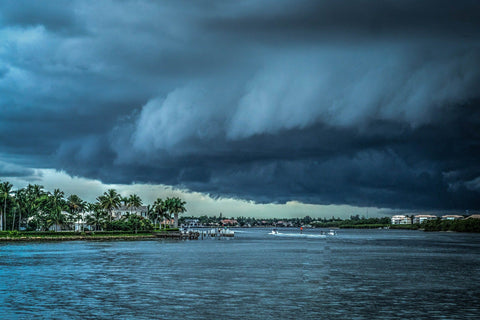Best Methods For Anchoring Your Jet Ski in Deep or Shallow Water
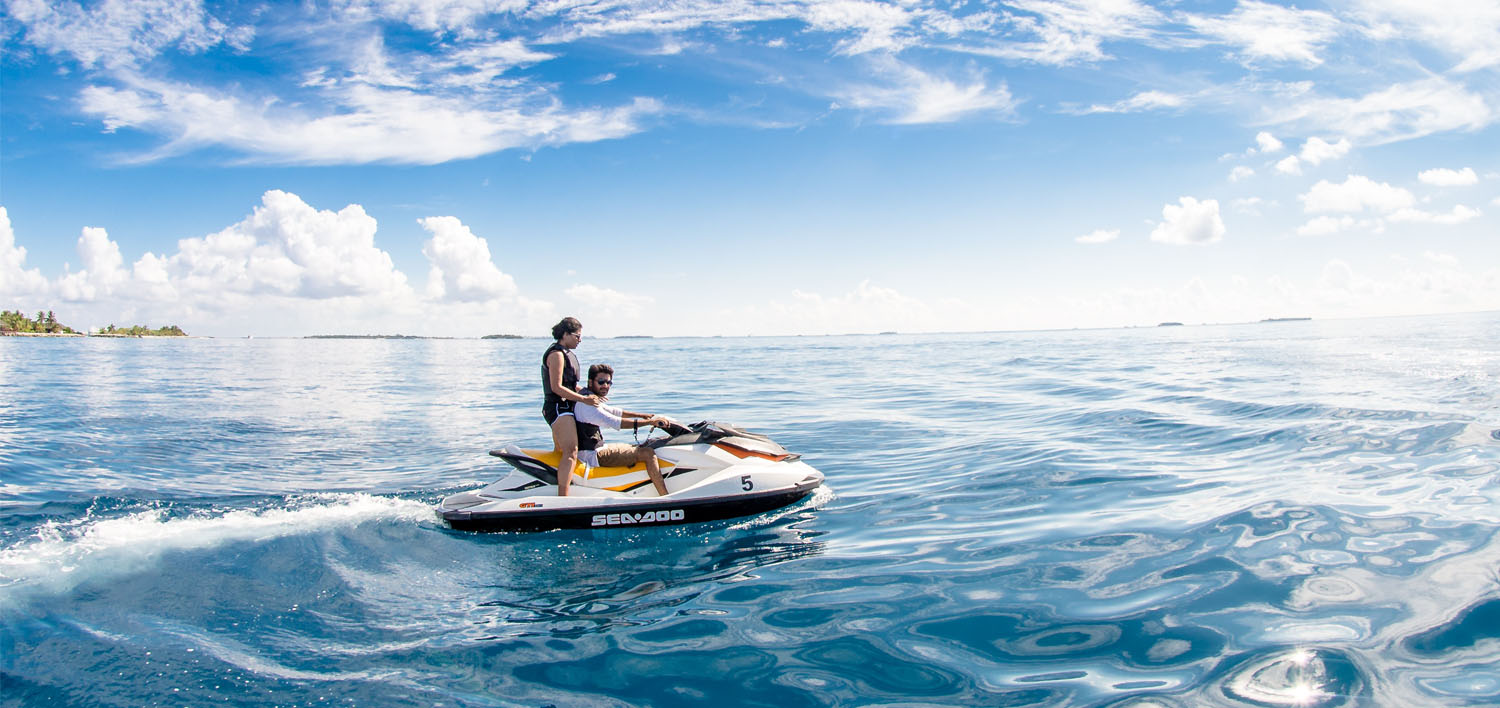
People love their jet skis and PWCs for their exciting maneuverability and freedom of travel that full-sized boats just can't offer. A PWC gives you an exhilarating way to explore hidden coves, go deep sea fishing, or even allows you to easily cruise right up to the beach for a quick leg stretch. However, this freedom of movement does come with its own set of challenges. The main challenge is that many of the secluded areas visited by PWC riders don't have actual docks or slips for you to tie up to. As a result, it's important to have the right gear and know-how when it comes time to take a break and drop the anchor. Follow along below as we discuss the best methods for anchoring in either shallow or deep water.
Shallow Water Anchoring
Whether you're fishing skinny water or beaching your PWC for some fun on the beach, it's important to make sure you protect yourself and your craft from unexpected danger by securely anchoring your craft in shallow water. The occasional hidden rock or hard hit from a beaching gone wrong can do a number on your craft, so take some time to review our best shallow water anchoring methods below and avoid causing unnecessary harm to you or your PWC.

Anchor Pole
 Anchor poles or pins provide excellent options for those looking for swift and secure anchoring in shallow water conditions. Anchor poles can be quickly deployed simply by pushing the pole firmly into the bottom. The recommended anchoring depth will vary depending on the height of the pole, but these typically work well at a depth up to around 4-5 feet. The PWC is then secured to the pole using anchor line or by adding mounting brackets directly to the craft. The beauty of the anchor pole is that it can quickly be retrieved and moved to another location so you can focus on having fun instead of spending time setting anchor. This ease of use has made the anchor pole a favorite among anglers who tend to fish shallow channels.
Anchor poles or pins provide excellent options for those looking for swift and secure anchoring in shallow water conditions. Anchor poles can be quickly deployed simply by pushing the pole firmly into the bottom. The recommended anchoring depth will vary depending on the height of the pole, but these typically work well at a depth up to around 4-5 feet. The PWC is then secured to the pole using anchor line or by adding mounting brackets directly to the craft. The beauty of the anchor pole is that it can quickly be retrieved and moved to another location so you can focus on having fun instead of spending time setting anchor. This ease of use has made the anchor pole a favorite among anglers who tend to fish shallow channels.
Pro tip: we strongly suggest adding a small buoy or float to your anchor pole so you don't lose it if it ever becomes dislodged.
| PROS | CONS |
| Can be set and retrieved within a matter of seconds. | Less likely to stay set with strong wind or current. |
| Works well in mud or sand. | Does not work well on a rocky bottom. |
| Most versions are collapsible to make transport and storage easier. | Even once collapsed, some anchor poles still may not fit in your PWC storage hatch. |
Screw Anchor
 Similar to the anchor pole, screw anchors are good shallow water anchoring solutions in sandy or muddy areas. Screw anchors typically are only recommended in depths up to 3 feet but provide better holding power by allowing you to anchor them deeper into the bottom than traditional poles. Their auger design drills down into sand or mud to give a firm hold that is less likely to become dislodged in high wind or current. Screw anchors keep your PWC in place using standard or stretchy anchor line and are typically adjustable to accommodate different depths.
Similar to the anchor pole, screw anchors are good shallow water anchoring solutions in sandy or muddy areas. Screw anchors typically are only recommended in depths up to 3 feet but provide better holding power by allowing you to anchor them deeper into the bottom than traditional poles. Their auger design drills down into sand or mud to give a firm hold that is less likely to become dislodged in high wind or current. Screw anchors keep your PWC in place using standard or stretchy anchor line and are typically adjustable to accommodate different depths.
Pro tip: just like the anchor pole, we strongly suggest adding a small buoy or float to your screw anchor so you don't lose it if it ever becomes dislodged.
| PROS | CONS |
| Can be set and retrieved fairly quickly. | Screw type anchors may require you to reach overboard or to get into the water to securely set them. |
| Provides more holding power over anchor poles. | May be more difficult to retrieve if you need to pull anchor quickly. |
| Most versions are collapsible to make transport and storage easier. | Even once collapsed, screw anchors still may not fit in your PWC storage hatch. |
| Works well in mud or sand. | Does not work well on a rocky bottom. |
Sand Bag Anchor
 Sand bag anchors offer the perfect combination of functionality and convenience when it comes to anchoring your PWC. Sand bag anchors don't take up any room in your storage hatch when empty, and can easily be filled with sand, rocks, or whatever else is laying around when it comes time to set anchor. The Norestar Sand Anchor holds up to 35lbs, creating a safe and secure anchor point for your personal watercraft. The sand bag anchors are ideal for shallow water or shore anchoring but can work quite well for deeper anchoring too. Plus, due to the storage-saving design of the empty anchor bag, you'll have plenty more room for longer anchor lines so you can be prepared for wherever your journey takes you.
Sand bag anchors offer the perfect combination of functionality and convenience when it comes to anchoring your PWC. Sand bag anchors don't take up any room in your storage hatch when empty, and can easily be filled with sand, rocks, or whatever else is laying around when it comes time to set anchor. The Norestar Sand Anchor holds up to 35lbs, creating a safe and secure anchor point for your personal watercraft. The sand bag anchors are ideal for shallow water or shore anchoring but can work quite well for deeper anchoring too. Plus, due to the storage-saving design of the empty anchor bag, you'll have plenty more room for longer anchor lines so you can be prepared for wherever your journey takes you.
| PROS | CONS |
| Extremely versatile - can be filled with sand, rocks, or any other heavy objects that can fit in the bag. | Can begin to drift under strong current or chop. |
| Works in both shallow and deeper water. | |
| They take up almost no room in storage when empty. | |
| Make excellent backup or secondary anchors. |
Beaching
 Beaching is the process of running your PWC right onto the beach to hop on and off the craft without having to dock or anchor offshore. This technique is achieved by slowly accelerating towards the beach, then cutting power once close to shore, and letting the momentum carry you onto the sand. While this method does allow you to "park" without a traditional dock or anchor, it is not recommended as it is quite dangerous and can easily lead to you harming yourself and/or your PWC. Repeated beaching of your PWC can lead to hull damage, impeller damage, and other various issues with your internal components.
Beaching is the process of running your PWC right onto the beach to hop on and off the craft without having to dock or anchor offshore. This technique is achieved by slowly accelerating towards the beach, then cutting power once close to shore, and letting the momentum carry you onto the sand. While this method does allow you to "park" without a traditional dock or anchor, it is not recommended as it is quite dangerous and can easily lead to you harming yourself and/or your PWC. Repeated beaching of your PWC can lead to hull damage, impeller damage, and other various issues with your internal components.
| PROS | CONS |
| Allows you to dismount your craft without using a dock or anchoring device. | Can lead to injury to yourself and others on the beach. |
| Will sustain unnecessary wear and tear to your PWC that could lead to major damage. | |
| Craft will need to be moved periodically to account for the tide. |
Shore Anchoring
 Shore anchoring still allows you quick access to the beach from your PWC while avoiding some of the wear and tear associated with beaching your craft. Instead of using your engine's momentum to carry you onto the beach, shore anchoring involves you cutting your engine and dismounting while still in the water, then using an anchor and line to hold your craft at the water's edge. When you're in a foot or two of water, cut the engine and attach an anchor line to your bow and pull your craft gently onto the sand. Then run your anchor, shore spike, or sand screw onto the beach and snug your line up. This method still allows you easy access to the beach without risking damage to your PWC or yourself in the process.
Shore anchoring still allows you quick access to the beach from your PWC while avoiding some of the wear and tear associated with beaching your craft. Instead of using your engine's momentum to carry you onto the beach, shore anchoring involves you cutting your engine and dismounting while still in the water, then using an anchor and line to hold your craft at the water's edge. When you're in a foot or two of water, cut the engine and attach an anchor line to your bow and pull your craft gently onto the sand. Then run your anchor, shore spike, or sand screw onto the beach and snug your line up. This method still allows you easy access to the beach without risking damage to your PWC or yourself in the process.
| PROS | CONS |
| Allows you to dismount your craft without using a dock or anchoring device. | Requires periodic adjustment to account for the tide. |
| Still gives you easy beach access similar to beaching, but with less risk of damage to yourself or your PWC. | There is still the risk of damage to your hull from scraping along sand or bumping into hidden rocks. |
Deep Water Anchoring
We know that most jet ski enthusiasts are too busy opening up the throttle and jetting across the water to think about taking a rest, but inevitably there will come a time when you're finally ready to power down and hop off your craft for a brief moment. Whether you're using this time to fish, snorkel, swim around, or just relax for a bit, you should always consider anchoring your craft while you do so to make sure it stays where it should. Below we will discuss the best methods for safely anchoring your PWC in deep water.

Folding Grapnel Anchor
 Folding grapnel anchors have long been convenient and trusted anchoring options for PWCs, kayaks, canoes, and other small crafts. These anchors are typically made of galvanized steel and feature 3 or 4 hinged flukes that can be folded in for easy storage or deployed out for additional holding power in the water. Folding grapnel anchors work well in most bottom conditions, but are best suited for rivers or rocky areas. Since these anchors don't take up much space in storage, boaters can easily carry one of these around as their backup anchor, or carry 2 folding grapnel anchors to be used on the bow and stern for additional holding power in rough chop.
Folding grapnel anchors have long been convenient and trusted anchoring options for PWCs, kayaks, canoes, and other small crafts. These anchors are typically made of galvanized steel and feature 3 or 4 hinged flukes that can be folded in for easy storage or deployed out for additional holding power in the water. Folding grapnel anchors work well in most bottom conditions, but are best suited for rivers or rocky areas. Since these anchors don't take up much space in storage, boaters can easily carry one of these around as their backup anchor, or carry 2 folding grapnel anchors to be used on the bow and stern for additional holding power in rough chop.
| PROS | CONS |
| Good mix of convenience and holding power for most PWCs. | Still heavier and more cumbersome than most shallow water anchoring systems. |
| Works very well in rivers or rocky bottoms. | Does not work as well in sand, mud, or other soft bottom conditions. |
| Most come in pre-assembled kits including anchor rope, floats, and stowage bags. |
Mushroom Anchor
 If you have a larger PWC or often carry multiple people on board with you, you may want to consider increasing your holding power by using a mushroom anchor. While mushroom anchors tend to be heavier and bulkier than other options, they do offer substantial holding power in silt, mud, or other soft bottoms. By burying themselves in mud or silt, these anchors will prevent your PWC from drifting in stronger wind or current to keep you safely in place.
If you have a larger PWC or often carry multiple people on board with you, you may want to consider increasing your holding power by using a mushroom anchor. While mushroom anchors tend to be heavier and bulkier than other options, they do offer substantial holding power in silt, mud, or other soft bottoms. By burying themselves in mud or silt, these anchors will prevent your PWC from drifting in stronger wind or current to keep you safely in place.
| PROS | CONS |
| Provide more holding power for larger PWCs or when carrying multiple people. | The size and shape of the mushroom anchor can be tricky to store in your PWC. |
| Effective in silt, mud, and other soft bottoms. | Does not work well on rock or other hard bottoms. |
| Vinyl coating protects the anchor for years of use and abuse. | Mushroom anchors are typically heavier, which can cause damage if it bounces around in the storage hatch. |
Fluke Anchor
 When you require serious holding power for your PWC, look no further than the Danforth style fluke anchor. While we admit that this anchor may be a little overkill for your average PWC enthusiast, if you've tried other solutions and still face issues of drifting at anchor, then this is the solution for you. The fluke anchor has excellent holding power in mud, sand, and gravel. While typically used for full-sized watercraft, a smaller 2 or 3 lb fluke anchor can still be stored on most personal watercraft and will provide you with very good holding power in heavy chop. Before you go this route, we suggest you take a close look at storage space since you will need to make sure you can carry this bulky anchor along with enough rope to keep you firmly in place.
When you require serious holding power for your PWC, look no further than the Danforth style fluke anchor. While we admit that this anchor may be a little overkill for your average PWC enthusiast, if you've tried other solutions and still face issues of drifting at anchor, then this is the solution for you. The fluke anchor has excellent holding power in mud, sand, and gravel. While typically used for full-sized watercraft, a smaller 2 or 3 lb fluke anchor can still be stored on most personal watercraft and will provide you with very good holding power in heavy chop. Before you go this route, we suggest you take a close look at storage space since you will need to make sure you can carry this bulky anchor along with enough rope to keep you firmly in place.
| PROS | CONS |
| Provides ultimate holding power for your PWC. | Takes up significantly more space in storage than other anchoring options. |
| Effective in silt, mud, sand, and other soft bottoms. | Not as effective in rocky bottoms. |
| Excellent option for divers or fishermen looking to stay at anchor for longer periods of time. |
Published
Recent Posts
Balancing Proven Tradition with Cutting-Edge Performance
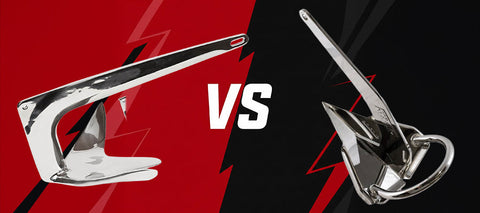
When choosing an anchor, it’s not a question of “traditional vs. modern”, despite our eye-catching article image *wink*, but "what combination of reliability, cost and performance best suits your specific needs?" Here’s a side-by-side look at why time-tested anchors remain indispensable even as shiny new designs continue to enter the market.
Windlass Problems? Common Issues and How to Fix Them
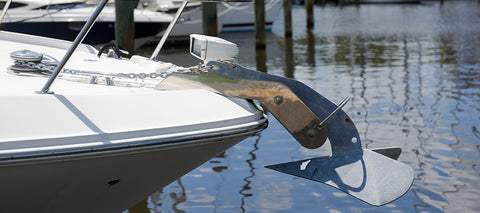
Let's look at common issues with windlasses and how to address them:
1) Windlass Won’t Run in Either Direction
2) Solenoid Clicks, but Windlass Won’t Move
3) Windlass Lacks Power to Haul the Anchor
4) Rode Gets Jammed or Doesn’t Come In
Our history: a 20 year journey
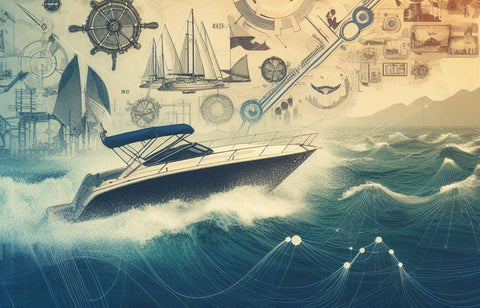
Boat Cleaning Tips for Anglers: Keeping Your Vessel Spotless and Pristine

Avast, Ye Mariners! Master the Art of Docking: A Swashbuckling Guide for Boaters
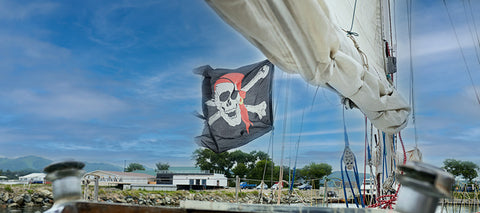
Top Reasons to Keep a Boating Maintenance Log
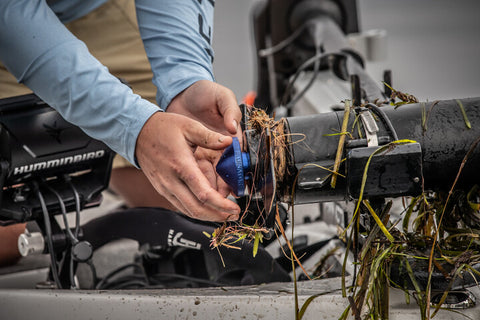
4 Top Tips for Buying a New-to-you Used Boat
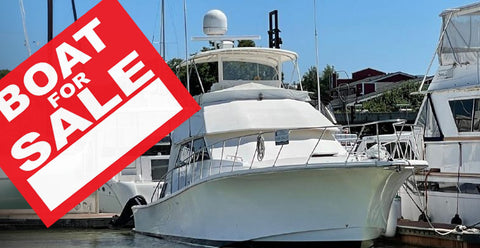
Bent Boat Anchor Shank: Common Causes and Prevention Tips
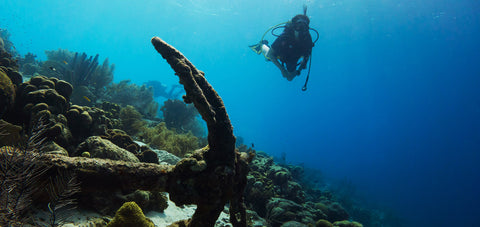
Prepare Your Boat For An Above Average Hurricane Season
